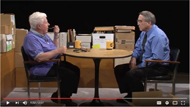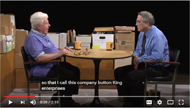Drew Williams1, Colleen Regan2, Jack Skelton-Miller2, Jessica McCall2, Caitlin Dobson2, Dennis Tomashek2, Sheikh Iqbal Ahamed1, Roger O. Smith2
1Math, Stat. and Comp. Sci. Department, Marquette University, Milwaukee, WI
2R2D2 Center, University of Wisconsin-Milwaukee, Milwaukee, WIAbstract
The ubiquity of the web allows primary sources and stories of the past to reach a wider audience than ever before. Archival websites, such as those used by university and public libraries, play a large role in showcasing these primary sources – ensuring the accessibility of these websites and the media contained therein is of utmost importance. Unfortunately, a “best practices” example of an archive website is difficult to come by. To remedy this problem, we’ve developed an accessible archive website to house The Fred Sammons Archives, media donated to the University of Wisconsin-Milwaukee by Fred Sammons, PhD (Hon.), OT, FAOTA. By focusing on both accessibility of the site housing the media, and the Fred Sammons Archives media itself, we hope to offer a top-tier experience for reading about the life and work of Fred Sammons for users of all abilities.
Introduction


Background
This project began as a direct result of the donation of the Fred Sammons Archive to the University of Wisconsin-Milwaukee – a collection of material representing the life and works of Fred Sammons. The American Occupational Therapy Association (AOTA) recently named Fred Sammons one of the most influential 100 people within the occupational therapy (OT) field. Sammons started his career in 1955 as an occupational therapist and continued for the next 60 years as an innovator and entrepreneur. In 1958, Sammons started Sammons-Preston as a mail-order business that sold adaptive equipment such as button hooks and swivel spoons. Sammons-Preston grew into a multi-million dollar national company and sells rehabilitative and medical equipment to most healthcare professionals.

Accessibility of Archival and Library Websites

Website Development and Universal Design
Our primary goal in developing the Fred Sammons website was to consider universal design – that is, design for all users of all abilities – first, and prioritize web accessibility. As an example of a gold standard of web accessibility, we turned to ACCESS-ed, a website that seeks to promote universal design in higher education. (R2D2 Center at the University of Wisconsin-Milwaukee., 2015) This website was also created with universal design in mind, evident by these site details:
- Equivalent Text Descriptions for non-text items (essential and detailed descriptions of non-text items for users with visual impairments.) (R2D2 Center of the University of Wisconsin-Milwaukee, 2015)
- A website design that emphasizes proper contrast and text size for all pages.
- Built-in controls for page contrast, font size, and page simplification
- Continuous updates to ensure compliance with standards/guidelines.
- An accessibility statement naming these accessibility features and promising to listen to ongoing feedback to ensure a fully accessible website in the future.

Case Study: The Fred Sammons Archives
The Fred Sammons Archive is comprised of multiple types of media: documents, videos, and photographs. The focus of the Fred Sammons Archive website is the proper display of these different types of media for an online audience. In developing the website, we worked to ensure both the accessibility of each of these types of media, and the website overall.
General Website Accessibility

The website itself was designed with proper color and contrast, and text that is no more than 15 words across the screen at any point for readability. This mirrors the readability standards for PowerPoint slides. The website is also designed to be responsive, shrinking and expanding elements as the screen size the website seeks to fit changes. Additionally, the navigation bar has been styled for maximum usability; when a user hovers over a link, an underline appears – the current page is indicated via a background highlight. Search is highlighted in the left sidebar of the website, and made available on all pages.
We have three main types of media to apply accessibility guidelines to: documents (typed and handwritten), video, and images.
Documents
All documents are visible in a PDF format with appropriate tagging, for proper screen reader use. To supplement this format, we also provide all handwritten text in an audio format, read aloud by Fred Sammons himself.
Video
As we’re using Youtube for hosting our video interviews, all video is uploaded in two individual files: a captioned video with the original audio work, and a video with audio descriptions added as appropriate, to provide context for actions occurring in the interview. Captions are displayed using Youtube’s built in captioning display services.
Images
Images are all equipped with both essential and detailed equivalent text descriptions. The former provides basic information about the contents of an image, and the latter provides additional information about the image for users with visual impairments. (R2D2 Center of the University of Wisconsin-Milwaukee, 2015)
We hope that these provisions will ensure that all users can properly access the media contained in the Fred Sammons Archives.
Conclusions
In conclusion, developing the Fred Sammons archives with universal design in mind from the start benefits our goal of ensuring the widest possible audience can benefit from his work and stories. We do plan on releasing this template for public use, with the hope that it can inspire other archive and library websites to ensure that their content meets accessibility standards. In doing this, we can ensure that users of all abilities can benefit from the information resources the internet and its archives can offer.References
American Occupational Therapy Association. (2017). 100 Influential People. Retrieved from The 100 Influential people: http://www.otcentennial.org/100-influential-people
Association of Research Libraries. (2014). Standards & Best Practices. Retrieved from Web Accessibility Toolkit: http://accessibility.arl.org/standards-best-practices/
Fulton, C. (2011). Web Accessibility, Libraries, and the Law. Information Technology and Libraries, 34-43. Retrieved from https://ejournals.bc.edu/ojs/index.php/ital/article/viewFile/3043/4837
Potter, A. (2012). A Vision of the Role and Future of Web Archives: The Web Archive in Today’s World. Library of Congress: The Signal. Retrieved from https://blogs.loc.gov/thesignal/2012/05/a-vision-of-the-role-and-future-of-web-archives-the-web-archive-in-todays-world/
R2D2 Center at the University of Wisconsin-Milwaukee. (2015). ACCESS-ed. Retrieved from ACCESS-ed: http://access-ed.r2d2.uwm.edu/
R2D2 Center of the University of Wisconsin-Milwaukee. (2015). Equivalent Text Descriptions. Retrieved from Access-ED: http://access-ed.r2d2.uwm.edu/EqTDs/
Riley-Huff, D. A. (2012, October). Web Accessibility and Universal Design : A Primer on Standards and Best Practices for Libraries. Retrieved from ALA TechSource: https://journals.ala.org/index.php/ltr/article/view/4687/5575
Web Accessibility Initiative. (2016, September). How to Meet WCAG 2.0. Retrieved from W3C: https://www.w3.org/WAI/WCAG20/quickref/Acknowledgements
We graciously thank Fred Sammons for his charitable donation of his work to the University of Wisconsin-Milwaukee. Without his contributions and support, this work would not have been possible.